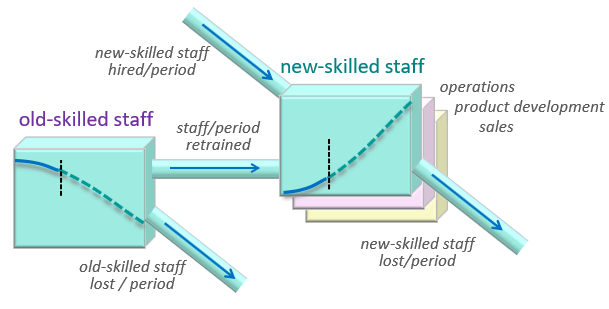A recent post explained how full strategic change may become essential when technology or other factors threaten to make our current business model obsolete. And the latest post explained how to migrate customers from the old business model to the new, while not losing them in the process!
But it’s people who operate the business system – both old and new – and it’s people who will build the new system. And it’s very likely that those skills needed in future will be quite different from the skills that managed the old system so well.
BEWARE, though! Remember we need to manage the wind-down of the old business [a] because there continue to be customers to serve, and we don’t want to lose them, and [b] because the old system is generating the cash flow to fund the building of the new system.
Transitioning the people
Returning to the case example, about IT-outsourcing [ITO] companies transitioning to offering business-process outsourcing [BPO] … The old operating skills were about effective management of client companies’ diverse hardware and software assets. We now need the skills to design and build business-process solutions, and to operate those services – not so much the IT stuff as the people-based services.
And the marketing and sales skills we need are different too. We are no longer pitching contracts to the Chief Information Officer to relieve her/him of the IT hassle – we are pitching to the Chief Operating Officer to replace large chunks of their business processes. (E.g. taking on the claims-handling operations for insurance companies. Note that by offering the same services to many similar clients, the BPO provider can be much more efficient and effective than any one of those clients. Hardly a novel idea – few firms today handle their own physical logistics!)
BUT don’t throw out the baby with the bath water!
So we really don’t need those old has-been staff with their obsolete skills, right? Best just let them go?
Figure 1: Transitioning the staff from operating the old business system to building and operating the new.

BUT we still need old-skill sales staff to resell our old proposition to customers who have not migrated, and we still need old-skill operating staff to deliver the old-proposition products, and old-skill support staff to serve those laggard customers. Sure – the numbers we need will fall, but not disappear overnight.
AND – just where are we going to find all those bright-eyed, bushy-tailed newbies with those new-age skills that we need? This is a novel capability we are building, and our competitors are likely chasing the same opportunity. There’s very likely a war-for-talent, so those newbies will not only be scarce, but costly too! So we need to conserve and leverage all the potential that we have.
Now, those old-skill staff will see the writing on the wall for their careers, but that will motivate them both to hang on to the jobs they have and – for those with the potential – to upgrade their skills for the brave new world.
Figure 1 summarises the staff-system transition that we have to plan and manage. Yes we will lose old-skill staff (bottom left). But we should also exploit every opportunity to retrain staff for the new business model (centre). And yes, we will also have to hunt for more new-skill staff (top), maybe looking to other related industries rather than fighting our rivals.
Challenges in planning and managing the staff transition
None of this will be easy:
- we have to manage this transition for all affected functions – sales, operations, customer support.
- and the potential for retraining may be more limited in some areas than others
- yes, those new-skill staff we cannot get from retraining will be hard to find and costly
- it is likely that the turnover rate for new-skill staff (bottom right) will be much higher than we are used to … which just makes the retraining and new-hiring challenges still harder.
All of which means we had better have a darned good plan for managing all of this! … for which purpose you really need a dynamic business model.
Our online courses explain how digital-twin models help to plan and manage all kinds of strategic and operational staffing challenges. But to get started, take the mini-course on strategic human-resource management.
As a thank you for following, get a ⅓ discount with coupon’blog33‘ at checkout – just £26.60.
The post Planning and managing strategic change [C] – transition the staffing appeared first on Kim Warren on Strategy.